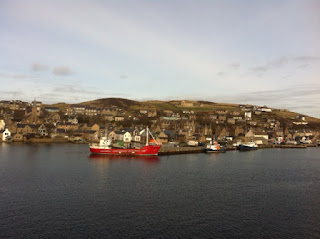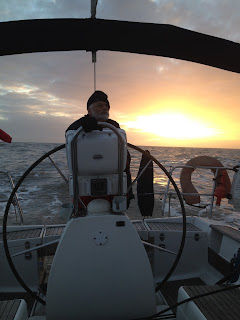We sail up to, and round Shetland, to the continued bemusement of locals.
After 2 weeks work, we caught the Saturday night ferry
back to Kirkwall and Ruby, arriving back on board at midnight. Very thankful for the central heating which
got the cabin up to comfortable temperature by the time Elsie had made the bed.
We had been unable to re-fuel before departure, as the
fuelling pontoon had broken loose in Spring gales and power had not yet been
restored. Volunteer staff had located a
wander lead in our absence, so this was our first task, not aided by a 20 knot
wind blowing us onto the berth. Out and
away, up to the North and back to Jack’s hole for the night. Westerly winds forecast for the next few days
– fair for a passage to Shetland. Much discussion as to whether we would do
this in one long hop (about 75 miles) or go via Fair Isle. The former seemed a bit far in big Atlantic
swells on our first full day back and the latter a little risky since there is
only one usable harbour, with a very confined anchorage and no pontoon (who
would need it this early in the year?) at the pier. In the end we decided on an early start;
route to Fair Isle and, if we didn’t like what we saw, we would have sufficient
daylight to make Shetland.
Up at 6 on Monday for a great sail up to Fair Isle with 2
reefs in the main giving us 8 knots plus through the water in a W’ly F5. Round the top, to avoid the rost off the
Southern tip and into North Haven. What
a lovely surprise! Beautifully sheltered and oversize fenders provided to keep
us off the black rubber of the pier. The
bird sanctuary was not open (too early – again) but we had a pleasant walk up
the hill to the airfield where I had once made a precautionary landing in a
helicopter.
Tuesday gave a great beam reach up to Scalloway with 2
reefs again in a WSWly F4-5. 4 Metre
Atlantic swells meant that Elsie was unwilling to go below and, as they were
behind the beam, gave us surges as we surfed down their fronts so that our mean
speed of 8 knots occasionally increased to over 10. George struggled a little as the passing swells
also yawed us and we regretted not rigging the wind steering. There are 3 potential entrances to Scalloway
and, with the swell and lack of local knowledge, we elected to take the widest,
North, entrance, around the wonderfully named island of Hildasay. In the smoother water inside, Elsie consented
to gybe round, even though we still had over 20 knots of wind; smoothly
done. And so confidence builds.
Scalloway sailing club had a brand new pontoon. Unusual in design, it has vertical wooden
facings and its uniform, light brown colour made it look initially like a
concrete pier causing us to overshoot to the marina, where there was clearly no
room. Back out and alongside the pontoon
tying up to chromed cleats. Very
posh. We had been told that we were the
first ever users, so took particular care.
Unfortunately neither water nor shore power had yet been connected. A friendly welcome and pint in the clubhouse
was only slightly damped by the news that the nightly mooing fee had been
increased from £10 to £15 together with a mandatory £1 per person for use of
showers, even though I had already used the boats facilities. I forbore to ask what the fee would be once
power and water were available.
Christening Scalloway's new pontoon.
Wednesday, the wind had backed to SW, still F 4-5, so another
wonderful sail round the coast, past Papa Stour and into Swarbacks Minn. We have both Imray and CCC pilot books on
board for Shetland and, following our Orkney experiences, are definitely taking
their advice. This was to go round both
Papa Stour and Ve Skerries, giving the latter a wide berth. Again gybed round, this time in in the full
swell but again smoothly accomplished.
Broad reach across St Magnus bay, dropping the main as we approached
Swarbacks head in case of gusts in the wind which was now gusting F6. A run up Busta Voe under Genoa to Brae. This sail furled early to prepare fenders and
lines, but we still made over 4 knots under bare poles. Into the marina, which I had watched being built
8 years earlier from my then lodging on the hill above and on to the pontoon
hammerhead. Plenty of room as the local
boats were still in their winter positions on the hard standing. Ashore for a meal at Frankie’s, Britain’s most
northerly (and highly recommended) chippie, use of laundry (a snip at £1 each
for washer and drier) and a beer with a couple of old colleagues.
The weather forecast again gave us a dilemma. Strong winds were forecast; Brae is a snug
haven and it was also my home-from-home for nearly 14 years. We could easily stay here for 2-3 days. Then the forecast changed to give us sailing
winds for Thursday and Friday (although stronger on Thursday night) with the
storm postponed until the weekend. This
would allow us to tick another box by rounding Muckle Flugga, the most
northerly point of the U.K., overnighting in Balta Sound, and down the East
coast to Burra Voe before the worst of the weather. Phone call to Balta Sound. Their pontoon also missing, which would mean
anchoring in less than ideal location, or tying up to the pier. The latter was definitely out and the former
risky if the weather was worse than forecast.
More consultation of pilot books revealed a suitable anchorage on the
east coast of the mainland, which would give us a good launch pad for Muckle
Flugga if the forecast improved. So,
after just one night in Brae, we set off again.
A pleasant beat (wouldn’t have put those two words together with the
previous headsail) down Busta Voe was followed by a good passage up the West
coast, close hauled, then reaching and finally running before the SWly
wind. By now the swell had built to over
5 metres so Elsie was definitely at edge of comfort zone. Round Ramna stacks (make the Needles look
pretty tame), another beat down Yell sound and into Ollaberry bay for a quiet
night at anchor.
Next morning, no improvement in the forecast, so heading
for good shelter for the weekend is called for.
The currents dictate that the passage through the bottom of Yell Sound
is best made mid-afternoon, so a lazy start and then a beat up Sullom Voe past
the oil terminal. The last time I had
seen it from seaward was in the ship simulator at Warsash some 30 years ago. Turned at Sullom jetty and ran back,
following the coastal route I had flown many times in a helicopter, into Burra
Voe on Yell. Onto the hammerhead. Oops, no cleats, posts or bollards, just
hoops to tie onto. Not the easiest
things to get ropes attached to from a yacht with an appreciable freeboard and
a crew who definitely does not leap ashore until all fast. We manage.
Burra Voe.
Another delightful harbour. Facilities, including showers and laundry
with honesty box are housed in an immaculate building roofed by an inverted lifeboat
from the Canberra. The village shop is
volunteer run and only opens one hour per day so we made sure that we were
there at 11 the next morning. A
surprisingly good selection and reasonable prices. The ‘pub’ is the village hall, which opens
for 4 hours on a Saturday evening but we were in luck! Not only were they
opening early to watch the Grand National but fish suppers were being served as
well. A good evening.
Sunday was another lazy day, just catching up on laundry
and other domestic tasks. An otter swam
under the pontoon, 10 ft away from the boat but, by the time Elsie looked, it
had gone.
Tuesday looked possible for another attempt at our
summit, Muckle Flugga, so we repositioned back to Ollaberry for the attempt,
entertaining ourselves on the way by beating right up Sullom Voe to Brae and
taking the dinghy ashore for provisions.
We are experimenting keeping dinghy on the foredeck, using an 8 ft spar
clipped onto the mast track and inner halliard as a crane for launch and recovery. Seems to work quite well, but modifications
will no doubt be made in time.
Tuesday – no go: winds still too strong and the Atlantic
swell will have had a week of F 6-8 to build.
Wednesday, still too strong for a clockwise transit but,
as the forecast is for the winds to die overnight and then to go more
Northerly, we decide to go the other way about.
So, once more through Yell Sound and another spirited sail with 2, then
3 reefs in W’ly F 5-7, up to Balta Sound and anchored as far in as possible.
Thursday, another early start and motored, in light airs,
round the northern tip off Unst, staying well out for the rost, across the top
and, finally, Muckle Flugga. We have now
achieved East (Norfolk) and North. Just
West (St Kilda?) and South (Scillies?) to go.
Passing M.F., we unfurled full genoa, to supplement already full main (making
its first appearance of the year!) and had a glorious reach back down to Yell
Sound. Motored through here, in light
airs and to anchor in Hamna Voe (Yell) in time to be disturbed by the late
helicopters going back to their roosts at Scatsta.
Friday, light airs.
Motored down to Lerwick. Fuelled
at Albert dock and introduced Elsie to Shetland’s answer to Harrods – Harry’s
department store. Then round to the
Marina at Gremista. Met by local who
showed us a snug berth and kindly gave me a lift to replenish camping gas. A resident of this marina - just across from the fish processors - is a seal who greets incoming boats, expecting to be fed.
Where's my fish supper?
Saturday, we were joined by Luke, a workmate and sometime
Cox of Aith Lifeboat, for a day sail round Whalsay. Enjoyable day, playing with staysail and
cruising chute before dying wind forced us to motor the last few miles. Luke had been programmed to be our 3rd
crew member on the delivery voyage, more than a year ago and was finally able
to wear the new deck shoes that he had bought for the occasion.
Ruby well moored fendered, cleaned and tidied, we
departed on the evening ferry back to Aberdeen for another 2 weeks work.
















